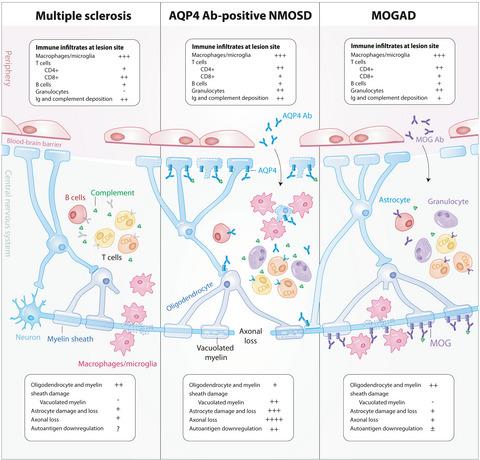当前位置:
X-MOL 学术
›
Clin. Transl. Immunol.
›
论文详情
Our official English website, www.x-mol.net, welcomes your
feedback! (Note: you will need to create a separate account there.)
Pathogenesis of autoimmune demyelination: from multiple sclerosis to neuromyelitis optica spectrum disorders and myelin oligodendrocyte glycoprotein antibody-associated disease
Clinical & Translational Immunology ( IF 4.6 ) Pub Date : 2021-07-26 , DOI: 10.1002/cti2.1316 Joseph A Lopez 1, 2 , Martina Denkova 1, 3 , Sudarshini Ramanathan 1, 4, 5 , Russell C Dale 1, 2, 4, 6 , Fabienne Brilot 1, 2, 3, 6
Clinical & Translational Immunology ( IF 4.6 ) Pub Date : 2021-07-26 , DOI: 10.1002/cti2.1316 Joseph A Lopez 1, 2 , Martina Denkova 1, 3 , Sudarshini Ramanathan 1, 4, 5 , Russell C Dale 1, 2, 4, 6 , Fabienne Brilot 1, 2, 3, 6
Affiliation

|
Autoimmunity plays a significant role in the pathogenesis of demyelination. Multiple sclerosis (MS), neuromyelitis optica spectrum disorders (NMOSD) and myelin oligodendrocyte glycoprotein antibody-associated disease (MOGAD) are now recognised as separate disease entities under the amalgam of human central nervous system demyelinating disorders. While these disorders share inherent similarities, investigations into their distinct clinical presentations and lesion pathologies have aided in differential diagnoses and understanding of disease pathogenesis. An interplay of various genetic and environmental factors contributes to each disease, many of which implicate an autoimmune response. The pivotal role of the adaptive immune system has been highlighted by the diagnostic autoantibodies in NMOSD and MOGAD, and the presence of autoreactive lymphocytes in MS lesions. While a number of autoantigens have been proposed in MS, recent emphasis on the contribution of B cells has shed new light on the well-established understanding of T cell involvement in pathogenesis. This review aims to synthesise the clinical characteristics and pathological findings, discuss existing and emerging hypotheses regarding the aetiology of demyelination and evaluate recent pathogenicity studies involving T cells, B cells, and autoantibodies and their implications in human demyelination.
中文翻译:

自身免疫性脱髓鞘的发病机制:从多发性硬化症到视神经脊髓炎谱系疾病和髓鞘少突胶质细胞糖蛋白抗体相关疾病
自身免疫在脱髓鞘的发病机制中起重要作用。多发性硬化症 (MS)、视神经脊髓炎谱系疾病 (NMOSD) 和髓鞘少突胶质细胞糖蛋白抗体相关疾病 (MOGAD) 现在被认为是人类中枢神经系统脱髓鞘疾病合并下的独立疾病实体。虽然这些疾病具有内在的相似性,但对其不同临床表现和病变病理的研究有助于鉴别诊断和了解疾病的发病机制。各种遗传和环境因素的相互作用导致了每种疾病,其中许多与自身免疫反应有关。NMOSD 和 MOGAD 中的诊断自身抗体突出了适应性免疫系统的关键作用,以及 MS 病变中自身反应性淋巴细胞的存在。虽然已经在 MS 中提出了许多自身抗原,但最近对 B 细胞贡献的强调为 T 细胞参与发病机制的公认理解提供了新的思路。本综述旨在综合临床特征和病理结果,讨论关于脱髓鞘病因的现有和新出现的假设,并评估最近涉及 T 细胞、B 细胞和自身抗体的致病性研究及其对人类脱髓鞘的影响。
更新日期:2021-07-27
中文翻译:

自身免疫性脱髓鞘的发病机制:从多发性硬化症到视神经脊髓炎谱系疾病和髓鞘少突胶质细胞糖蛋白抗体相关疾病
自身免疫在脱髓鞘的发病机制中起重要作用。多发性硬化症 (MS)、视神经脊髓炎谱系疾病 (NMOSD) 和髓鞘少突胶质细胞糖蛋白抗体相关疾病 (MOGAD) 现在被认为是人类中枢神经系统脱髓鞘疾病合并下的独立疾病实体。虽然这些疾病具有内在的相似性,但对其不同临床表现和病变病理的研究有助于鉴别诊断和了解疾病的发病机制。各种遗传和环境因素的相互作用导致了每种疾病,其中许多与自身免疫反应有关。NMOSD 和 MOGAD 中的诊断自身抗体突出了适应性免疫系统的关键作用,以及 MS 病变中自身反应性淋巴细胞的存在。虽然已经在 MS 中提出了许多自身抗原,但最近对 B 细胞贡献的强调为 T 细胞参与发病机制的公认理解提供了新的思路。本综述旨在综合临床特征和病理结果,讨论关于脱髓鞘病因的现有和新出现的假设,并评估最近涉及 T 细胞、B 细胞和自身抗体的致病性研究及其对人类脱髓鞘的影响。











































 京公网安备 11010802027423号
京公网安备 11010802027423号